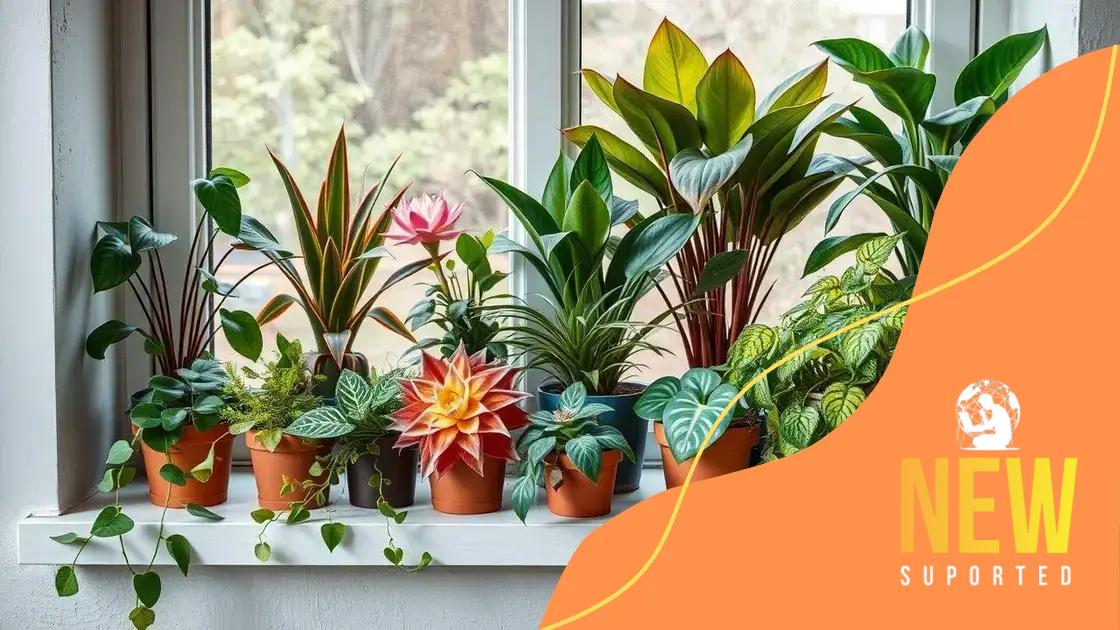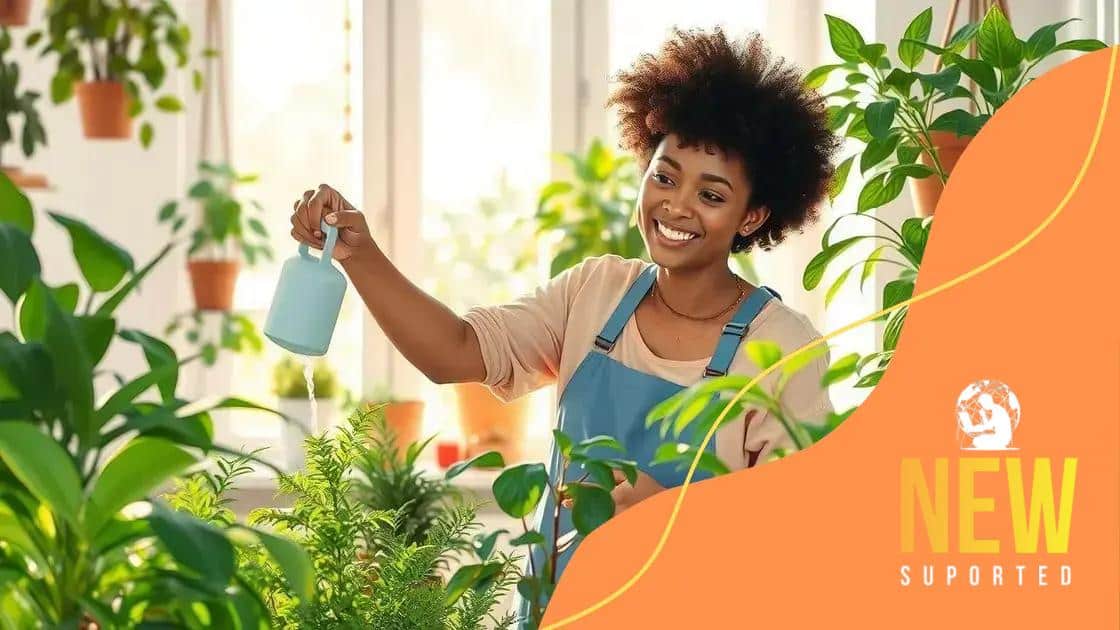The best indoor plants for purifying home air

The best indoor plants for purifying home air include snake plants, peace lilies, and spider plants, which effectively filter toxins while enhancing your living space’s aesthetic and mental well-being.
Do you know how much of a difference the best indoor plants for purifying home air can make in your living space? These green companions do more than just beautify; they actively improve the air we breathe. Let’s dive into how these plants can enhance your home environment.
Why indoor plants matter for air quality
Why do indoor plants matter for air quality? These green wonders are not just for decoration; they can significantly enhance the air we breathe. Recent studies suggest that certain plants can filter harmful toxins from the air, creating a healthier living environment for you and your family.
One of the main reasons indoor plants improve air quality is their ability to absorb carbon dioxide and release oxygen. This natural process not only refreshes the air but also contributes to a more pleasant atmosphere in your home. By incorporating these plants, you can reduce the levels of contaminants like benzene, formaldehyde, and xylene commonly found in indoor environments.
Types of Indoor Plants That Purify Air
Many indoor plants are known for their air-purifying qualities. Here are some popular choices:
- Snake Plant: Very low maintenance and effective in removing toxins.
- Pothos: Grows quickly and is great for various light conditions.
- Peace Lily: Beautiful blooms and known for its ability to absorb mold spores.
- Spider Plant: Excellent at removing formaldehyde and other chemicals.
By choosing the right plants, you can effortlessly enhance your indoor air quality. The process is simple: place several plants throughout your home, ensuring they receive the appropriate amount of light and water. Remember, the more plants you have, the greater their impact on the air you breathe. Plus, nurturing these plants can be a rewarding experience, giving you a sense of accomplishment and peace.
Adding plants to your home also has psychological benefits. The presence of greenery can lower stress levels, enhance concentration, and improve your overall well-being. So, not only do indoor plants purify air, but they also contribute to a happier and healthier lifestyle.
Top 5 plants for purifying home air
Choosing the right plants can greatly enhance your indoor air quality. Here are the top 5 plants for purifying home air, each with unique benefits.
1. Snake Plant
The snake plant is popular for its resilience and air-purifying abilities. It converts carbon dioxide to oxygen at night, making it a fantastic bedroom companion. Plus, it thrives on neglect, needing minimal care.
2. Peace Lily
This stunning plant not only adds beauty to your space but is also excellent for removing toxins like ammonia and formaldehyde. The peace lily blooms gorgeous white flowers, signaling to you that it’s time for care.
3. Spider Plant
The spider plant is a fantastic choice for beginners. Known for its ability to remove indoor pollutants, this plant produces offshoots, making it easy to propagate and share with friends.
4. Pothos
Pothos is adaptable to various lighting conditions and helps eliminate chemicals like xylene and benzene from the air. Its trailing vines can beautify any space, adding a touch of nature indoors.
5. Areca Palm
This tropical plant is one of the best humidifiers among houseplants. It’s effective at filtering out toxins and can significantly raise the humidity in dry rooms, making your environment more comfortable.
By adding these top plants to your home, you not only improve air quality but also create a relaxing and inviting atmosphere. Arrange them in strategic areas around your home to enjoy their benefits fully.
Caring for your indoor plants

Caring for your indoor plants is essential for maintaining their health and maximizing their air-purifying benefits. Regular attention can help them thrive, ensuring your home stays fresh and vibrant.
Watering
Understanding how much to water your plants is crucial. Overwatering can lead to root rot, while underwatering can cause wilting. It’s best to check the soil moisture. If the top inch feels dry, it’s time to water. Always ensure that pots have proper drainage to prevent water from pooling.
Light Requirements
Each plant has specific light needs. Some thrive in bright, indirect light, while others prefer low-light conditions. Placing your plants in the right spot is key to their success. Rotate them occasionally to ensure even growth and exposure to sunlight.
Humidity and Temperature
Indoor plants generally enjoy humidity. If your home is dry, especially in winter, consider misting your plants or using a humidifier. Most indoor plants prefer temperatures between 60°F and 75°F (15°C to 24°C). Keep them away from cold drafts or direct heat vents.
Fertilizing
During the growing season, which is typically spring and summer, fertilize your plants every 4-6 weeks. Use a balanced, water-soluble fertilizer to provide essential nutrients. In fall and winter, most indoor plants need less fertilizer.
Regularly inspect your plants for pests and diseases. Early detection can save your plants and ensure they continue purifying your air effectively. Keep the leaves clean by wiping them with a damp cloth to enhance their ability to photosynthesize.
Following these simple care tips will help your indoor plants thrive, providing you with cleaner air and a more enjoyable living space.
Placement tips for maximum air purification
Placement of your indoor plants is key to maximizing their air purification abilities. Understanding how to arrange your plants can enhance their effectiveness in cleaning the air.
Consider Light Levels
Each indoor plant has specific light requirements. For example, snake plants and pothos prefer bright, indirect light, while peace lilies can thrive in lower light conditions. Place plants where they can access their ideal light to boost their growth and purifying power.
Group Plants Together
Grouping plants can create a microenvironment with higher humidity, beneficial for plants that enjoy moisture. Consider placing plants with similar light and water needs next to each other. This not only improves their health but also amplifies their air-purifying effects.
Avoid Drafts and Heat Sources
Keep plants away from cold drafts and heat sources, such as air conditioning vents or radiators. Sudden temperature changes can stress plants, affecting their ability to purify air effectively. Aim for a stable and comfortable environment for them to thrive.
Also, think about the placement of plants throughout your home. Areas where you spend the most time, like living rooms and bedrooms, should have air-purifying plants to benefit from their cleaning capabilities. A plant in the corner of a seldom-visited room might not provide the same advantages.
Regularly change the arrangement of your plants to suit seasonal changes and ensure they continue receiving the best light and conditions for growth. This keeps your living space fresh and the plants healthy, enhancing your indoor air quality.
Common misconceptions about indoor plants
There are many common misconceptions about indoor plants that can lead to misunderstandings in care and maintenance. Clearing up these myths can help you choose the right plants for your home and ensure they thrive.
Myth 1: Indoor Plants Don’t Need Light
Some people believe that indoor plants don’t require much light. In reality, most indoor plants need at least some light to grow healthy. While certain species can survive in low light, many will do best in bright, indirect sunlight.
Myth 2: All Indoor Plants Are Toxic
Another misconception is that all indoor plants are dangerous for pets or children. While some plants can be toxic, there are many non-toxic options available. Plants like spider plants and Boston ferns are safe choices.
Myth 3: More Water Means Healthier Plants
It’s common to think that the more water you give, the healthier the plant will be. Overwatering can lead to root rot and other issues. It’s essential to know each plant’s water needs and to check the soil moisture before watering.
Myth 4: Indoor Plants Can Purify Air Completely
While it’s true that many indoor plants can improve air quality, they don’t completely purify the air in a room. They can help reduce certain toxins, but a well-ventilated space is also important for good air quality.
Understanding these misconceptions can enhance your experience with indoor plants. By doing proper research and learning about the needs of each plant, you can create a thriving indoor garden that benefits your home environment.
In summary, having indoor plants can significantly improve your home environment. They not only enhance air quality, but also add beauty and a sense of calm to your space. Understanding how to care for them, knowing their placement, and dispelling common misconceptions will help you enjoy the many benefits of indoor gardening. By selecting the right plants and giving them proper attention, you can create a healthy and inviting atmosphere in your home.
\n
\n
FAQ – Frequently Asked Questions about Indoor Plants
Do indoor plants really improve air quality?
Yes, indoor plants can help filter out toxins and increase oxygen levels, contributing to a healthier indoor environment.
How often should I water my indoor plants?
Watering frequency depends on the plant type. Generally, you should check the top inch of the soil; if it’s dry, it’s time to water.
Are all indoor plants safe for pets?
No, some indoor plants can be toxic to pets. It’s important to research which plants are safe if you have animals in your home.
How can I care for indoor plants in low light?
Choose low-light tolerant plants, like snake plants or pothos, and rotate them occasionally to make sure all sides receive some light.






